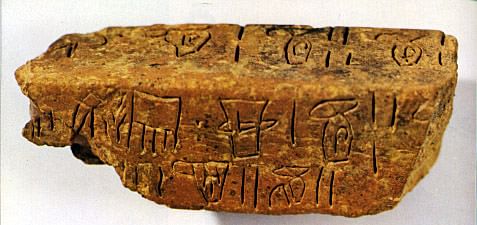Linear A Script › Antique Origins
Linear A Script
DEFINITION AND ORIGINS

The Linear A script was the writing system used by the Minoan civilization. Examples of this script have been recovered from Cretan sites such as Hagia Triada, Knossos, and Phaistos. Additional examples of the Linear A script have also been found outside of Crete, including the site of Trianda (Ialysos) on the north-west coast of Rhodes and Miletus, a testimony of the cultural links with the Minoans. Unfortunately, the Linear A script remains undeciphered.

ORIGIN OF THE LINEAR A SCRIPT
Late in the 19th century CE, the English archaeologist Sir Arthur Evans published a paper named 'Cretan pictographs and the prae-Phoenician script', based on the study of a number of signs and short inscriptions found on Crete and mainland Greece.During the excavations conducted by Evans at the site of Knossos in 1901 CE, an archive of clay tablets was identified, similar to many clay tablets archives found in the Near East. The tablets retrieved by Evans recorded a number of scripts, all of which were different from the scripts known thus far.
MANY STUDIES HAVE TRIED TO IDENTIFY THE LANGUAGE BEHIND LINEAR A, BUT NONE HAVE PRODUCED CONVINCING RESULTS
The oldest of these signs was a pictographic writing system developed around 2000 BCE known today as Cretan hieroglyphs.Another group of signs was identified as Linear A, developed around 1700 BCE. While Cretan hieroglyphs have a pictorial appearance, Linear A has a linear appearance: most documented clay tablet Linear A inscriptions are arranged in square fields, typically four to nine lines long. Neither of these writing systems has been deciphered yet. It has been speculated that both Cretan hieroglyphs and Linear A represent the same language. The number of Linear A signs identified ranges from 77 to 85 according to different scholars, suggesting that this was a syllabic writing system.Many studies have tried to identify the language behind Linear A, but none have produced convincing results. Many scholars have argued that Linear A represents a pre- Hellenic language unrelated to Greek. Some theories have gone even further claiming that the Linear A language does not even belong to the Indo-European language family. Other studies have speculated that Linear A is related to the Old European Vinca culture.Another group of signs identified by Evans was the Linear B script. Although Evans never knew it, Linear B is an adaptation of Linear A employed to represent an archaic form of the Greek language. Linear B was deciphered in 1953 CE by Michael Ventris, more than a decade after the death of Sir Arthur Evans.
Late in the 19th century CE, the English archaeologist Sir Arthur Evans published a paper named 'Cretan pictographs and the prae-Phoenician script', based on the study of a number of signs and short inscriptions found on Crete and mainland Greece.During the excavations conducted by Evans at the site of Knossos in 1901 CE, an archive of clay tablets was identified, similar to many clay tablets archives found in the Near East. The tablets retrieved by Evans recorded a number of scripts, all of which were different from the scripts known thus far.
MANY STUDIES HAVE TRIED TO IDENTIFY THE LANGUAGE BEHIND LINEAR A, BUT NONE HAVE PRODUCED CONVINCING RESULTS
The oldest of these signs was a pictographic writing system developed around 2000 BCE known today as Cretan hieroglyphs.Another group of signs was identified as Linear A, developed around 1700 BCE. While Cretan hieroglyphs have a pictorial appearance, Linear A has a linear appearance: most documented clay tablet Linear A inscriptions are arranged in square fields, typically four to nine lines long. Neither of these writing systems has been deciphered yet. It has been speculated that both Cretan hieroglyphs and Linear A represent the same language. The number of Linear A signs identified ranges from 77 to 85 according to different scholars, suggesting that this was a syllabic writing system.
Many studies have tried to identify the language behind Linear A, but none have produced convincing results. Many scholars have argued that Linear A represents a pre- Hellenic language unrelated to Greek. Some theories have gone even further claiming that the Linear A language does not even belong to the Indo-European language family. Other studies have speculated that Linear A is related to the Old European Vinca culture.
Another group of signs identified by Evans was the Linear B script. Although Evans never knew it, Linear B is an adaptation of Linear A employed to represent an archaic form of the Greek language. Linear B was deciphered in 1953 CE by Michael Ventris, more than a decade after the death of Sir Arthur Evans.
MATERIAL FORM & USE
Although the Linear A script remains undeciphered, some scholars have attempted to understand the overall message of some Linear A texts based on functional comparison with the Linear B script. Based on these studies, it has been argued that Linear A inscriptions are concerned with accounting data and other forms of record keeping and administration. This position is consistent with the fact that Minoan palaces had a remarkable storage capacity and are believed to have acted as redistribution centres.
Although the Linear A script remains undeciphered, some scholars have attempted to understand the overall message of some Linear A texts based on functional comparison with the Linear B script. Based on these studies, it has been argued that Linear A inscriptions are concerned with accounting data and other forms of record keeping and administration. This position is consistent with the fact that Minoan palaces had a remarkable storage capacity and are believed to have acted as redistribution centres.

Knossos
Some Linear A inscriptions have been found on libation tables, associated with ritual and religious items (eg votive terracotta or bronze figurines with ritual gestures, gold jewellery, pottery and stone vessels) found at sanctuaries located on or near mountain summits dated to Minoan times, sometimes referred to as rural sanctuaries or peak sanctuaries. This is a possible example of ritual or religious use of the Linear A script.Most examples of Linear A have been found on clay tablets. Other examples have been identified on pottery sherds, seal-stones, steatite seals and pendants, and inscribed building blocks.
Some Linear A inscriptions have been found on libation tables, associated with ritual and religious items (eg votive terracotta or bronze figurines with ritual gestures, gold jewellery, pottery and stone vessels) found at sanctuaries located on or near mountain summits dated to Minoan times, sometimes referred to as rural sanctuaries or peak sanctuaries. This is a possible example of ritual or religious use of the Linear A script.
Most examples of Linear A have been found on clay tablets. Other examples have been identified on pottery sherds, seal-stones, steatite seals and pendants, and inscribed building blocks.
DECLINE OF THE LINEAR A SCRIPT
Around 1450 BCE, the Linear B script was developed. Linear B is the earliest written form of Greek that we know of. Since this script shares many signs with the older Linear A, it has been inferred that Linear B came into existence when scribes adapted Linear A to a new language: Greek. This idea is further supported by the fact that Linear B is poorly suited to writing Greek.As the Mycenaean civilization was rising in the mid-2nd millennium BCE and the Minoans were declining, the Linear B script replaced the older Linear A. By c. 1450 BCE, most Minoan sites on Crete were destroyed and the Linear A script in Knossos was replaced by the Linear B. Finally by c. 1400 BCE, the Linear A script was completely abandoned and all writing in Greece and Crete was recorded using Linear B.
Around 1450 BCE, the Linear B script was developed. Linear B is the earliest written form of Greek that we know of. Since this script shares many signs with the older Linear A, it has been inferred that Linear B came into existence when scribes adapted Linear A to a new language: Greek. This idea is further supported by the fact that Linear B is poorly suited to writing Greek.
As the Mycenaean civilization was rising in the mid-2nd millennium BCE and the Minoans were declining, the Linear B script replaced the older Linear A. By c. 1450 BCE, most Minoan sites on Crete were destroyed and the Linear A script in Knossos was replaced by the Linear B. Finally by c. 1400 BCE, the Linear A script was completely abandoned and all writing in Greece and Crete was recorded using Linear B.
LICENSE:
Article based on information obtained with permission from the Website Ancient History EncyclopediaContent is available under License Creative Commons: Attribution-NonCommercial-ShareAlike 3.0 Unported. CC-BY-NC-SA License
Article based on information obtained with permission from the Website Ancient History Encyclopedia
Content is available under License Creative Commons: Attribution-NonCommercial-ShareAlike 3.0 Unported. CC-BY-NC-SA License